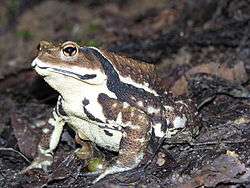Definify.com
Definition 2025
蝦蟇
蝦蟇
Japanese

蝦蟇 (gama, gamagaeru): a Japanese common toad.
Etymology 1
| Kanji in this term | |
|---|---|
| 蝦 | 蟇 |
|
か > が Jinmeiyō |
ま Hyōgaiji |
| on'yomi | |
Appears to be from borrowing from Middle Chinese 蝦蟇 (/ɣa ma/, “toad”, literally “shrimp, prawn + toad”).
Pronunciation
- On'yomi
- (Tokyo) がま [gáꜜmà] (Atamadaka - [1])[1]
- (Tokyo) がま [gàmá] (Heiban - [0])[1]
- IPA(key): [ɡa̠ma̠]
Alternative forms
Noun
蝦蟇 (hiragana がま, katakana ガマ, romaji gama)
- a toad
Usage notes
As with many terms that name organisms, this term is often spelled in katakana in biological contexts, as ガマ.
Synonyms
- 蟇蛙 (hikigaeru)
Etymology 2
| Kanji in this term | |
|---|---|
| 蝦 | 蟇 |
| Jinmeiyō | Hyōgaiji |
| Irregular | |
Appears to be a compound of 蟇 (gama, “toad”) + 蝦 (kaeru, “frog”). The kaeru changes to gaeru as an instance of rendaku (連濁). . The kanji in this term are reversed as jukujikun (熟字訓) to match the Chinese spelling of the borrowed term gama (see above).
Pronunciation
Noun
蝦蟇 (hiragana がまがえる, romaji gamagaeru, historical hiragana がまがへる)
- a toad